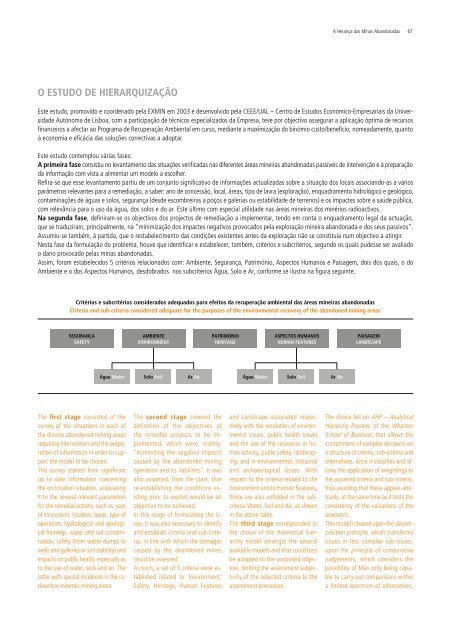Livro EDM
"A Herança das Minas Abandonadas - O Enquadramento e a Situação em Portugal"
"A Herança das Minas Abandonadas - O Enquadramento e a Situação em Portugal"
Create successful ePaper yourself
Turn your PDF publications into a flip-book with our unique Google optimized e-Paper software.
A Herança das Minas Abandonadas 67<br />
O ESTUDO DE HIERARQUIZAÇÃO<br />
Este estudo, promovido e coordenado pela EXMIN em 2003 e desenvolvido pela CEEE/UAL – Centro de Estudos Económico-Empresariais da Universidade<br />
Autónoma de Lisboa, com a participação de técnicos especializados da Empresa, teve por objectivo assegurar a aplicação óptima de recursos<br />
financeiros a afectar ao Programa de Recuperação Ambiental em curso, mediante a maximização do binómio custo/benefício, nomeadamente, quanto<br />
à economia e eficácia das soluções correctivas a adoptar.<br />
Este estudo contemplou várias fases:<br />
A primeira fase consistiu no levantamento das situações verificadas nas diferentes áreas mineiras abandonadas passíveis de intervenção e à preparação<br />
da informação com vista a alimentar um modelo a escolher.<br />
Refira-se que esse levantamento partiu de um conjunto significativo de informações actualizadas sobre a situação dos locais associando-as a vários<br />
parâmetros relevantes para a remediação, a saber: ano de concessão, local, áreas, tipo de lavra (exploração), enquadramento hidrológico e geológico,<br />
contaminações de águas e solos, segurança (desde escombreiras a poços e galerias ou estabilidade de terrenos) e os impactes sobre a saúde pública,<br />
com relevância para o uso da água, dos solos e do ar. Este último com especial utilidade nas áreas mineiras dos minérios radioactivos.<br />
Na segunda fase, definiram-se os objectivos dos projectos de remediação a implementar, tendo em conta o enquadramento legal da actuação,<br />
que se traduziram, principalmente, na “minimização dos impactes negativos provocados pela exploração mineira abandonada e dos seus passivos”.<br />
Assumiu-se também, à partida, que o restabelecimento das condições existentes antes da exploração não se constituía num objectivo a atingir.<br />
Nesta fase da formulação do problema, houve que identificar e estabelecer, também, critérios e subcritérios, segundo os quais pudesse ser avaliado<br />
o dano provocado pelas minas abandonadas.<br />
Assim, foram estabelecidos 5 critérios relacionados com: Ambiente, Segurança, Património, Aspectos Humanos e Paisagem, dois dos quais, o do<br />
Ambiente e o dos Aspectos Humanos, desdobrados nos subcritérios Água, Solo e Ar, conforme se ilustra na figura seguinte.<br />
Critérios e subcritérios considerados adequados para efeitos da recuperação ambiental das áreas mineiras abandonadas<br />
Criteria and sub-criteria considered adequate for the purposes of the environmental recovery of the abandoned mining areas<br />
SEGURANÇA<br />
SAFETY<br />
AMBIENTE<br />
ENVIRONMENT<br />
PATRIMÓNIO<br />
HERITAGE<br />
ASPECTOS HUMANOS<br />
HUMAN FEATURES<br />
PAISAGEM<br />
LANDSCAPE<br />
Água Water<br />
Solo Soil<br />
Ar Air<br />
Água Water<br />
Solo Soil<br />
Ar Air<br />
The first stage consisted of the<br />
survey of the situations in each of<br />
the diverse abandoned mining areas<br />
requiring intervention and the preparation<br />
of information in order to support<br />
the model to be chosen.<br />
This survey started from significant<br />
up to date information concerning<br />
the on location situation, associating<br />
it to the several relevant parameters<br />
for the remedial actions, such as: year<br />
of concession, location, areas, type of<br />
operation, hydrological and geological<br />
framings, water and soil contamination,<br />
safety (from waste dumps to<br />
wells and galleries or soil stability) and<br />
impacts on public health, especially as<br />
to the use of water, soils and air. The<br />
latter with special incidence in the radioactive<br />
minerals mining areas.<br />
The second stage covered the<br />
definition of the objectives of<br />
the remedial projects to be implemented,<br />
which were, mainly,<br />
“minimizing the negative impacts<br />
caused by the abandoned mining<br />
operation and its liabilities”. It was<br />
also assumed, from the start, that<br />
re-establishing the conditions existing<br />
prior to exploit would be an<br />
objective to be achieved.<br />
In this stage of formulating the issue,<br />
it was also necessary to identify<br />
and establish criteria and sub-criteria,<br />
in line with which the damages<br />
caused by the abandoned mines<br />
could be assessed.<br />
As such, a set of 5 criteria were established<br />
related to: Environment,<br />
Safety, Heritage, Human Features<br />
and Landscape associated respectively<br />
with the resolution of environmental<br />
issues, public health issues<br />
and the use of the resources in human<br />
activity, public safety, landscaping,<br />
and in environmental, industrial<br />
and archaeological issues. With<br />
respect to the criteria related to the<br />
Environment and to Human Features,<br />
these are also unfolded in the subcriteria<br />
Water, Soil and Air, as shown<br />
in the above table.<br />
The third stage corresponded to<br />
the choice of the theoretical hierarchy<br />
model amongst the several<br />
available models and that could best<br />
be adapted to the proposed objective,<br />
limiting the assessment subjectivity<br />
of the selected criteria to the<br />
assessment procedure.<br />
The choice fell on AHP – Analytical<br />
Hierarchy Process, of the Wharton<br />
School of Business, that allows the<br />
containment of complex decisions on<br />
a structure of criteria, sub-criteria and<br />
alternatives, since it classifies and allows<br />
the application of weightings to<br />
the assumed criteria and sub-criteria,<br />
thus avoiding that these appear arbitrarily,<br />
at the same time as it tests the<br />
consistency of the valuations of the<br />
assessors.<br />
This model is based upon the decomposition<br />
principle, which transforms<br />
issues in less complex sub-issues,<br />
upon the principle of comparative<br />
judgements, which considers the<br />
possibility of Man only being capable<br />
to carry out comparisons within<br />
a limited spectrum of alternatives,


